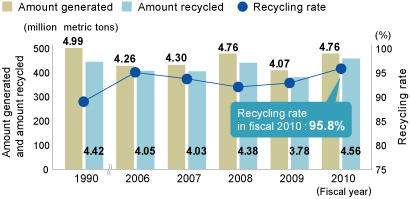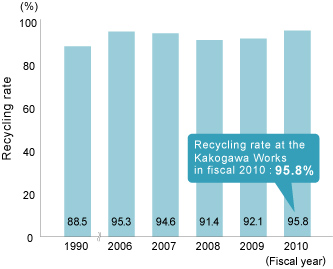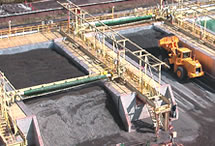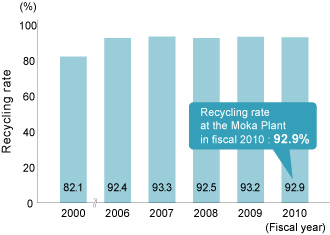Home > About Us > Sustainability Management > Sustainability Report > Sustainability Report 2011 > Promoting Recycling
 Promoting Recycling
Promoting Recycling
| Reducing waste and promoting recycling to effectively harness limited resources |
As our operations cover such a wide field, including materials and industrial machinery, we strive to keep waste to an absolute minimum at each of our locations. We also make every effort to reuse and recycle byproducts from our manufacturing processes, so as to make the best possible use of the limited resources we have available.
Curbing Waste Product Generation and Promoting Recycling
In fiscal 2010, the Kobe Steel Group generated 5.12 million metric tons of byproducts (waste), 98.7% of which was produced as part of our Iron & Steel Business. We have continued to promote efforts to recycle steel slag, dust and other byproducts generated at our works as a result of the steelmaking process. In fiscal 2010, our recycling rate came to 95.8% for all Kobe Steel plants, and 95.3% for the entire Group.
In addition to reinforcing the quality control of steel slag* during fiscal 2010, we also managed to reduce the volume of waste sent to landfill through initiatives such as switching to operating methods that do not use fluorine and other auxiliary materials that impede recycling. Despite sending a certain amount of waste to landfill as a result of construction and other work, the Kobe Steel Group sent around 210,000 tons of waste to landfill overall, representing a 30% reduction compared to the previous year.
We will continue to develop recycling technologies and minimize levels of waste in the future in an effort to further reduce the volume of waste that we send to landfill.
* Slag: Byproduct separated and recovered from molten iron and steel during the refining process
Byproducts Generated by Business Segment (including group companies)

Amount of Waste Byproduct Generated, Amount Recycled & Recycling Rate (parent only)

Plants Aim for Zero Emissions
All plants and works have drawn up Action Programs to cut the quantity of waste sent to landfill and are continuing efforts for reuse and recycling.
Iron & Steel Business
Recycling Byproducts
The Kakogawa Works has been running a zero-emission campaign to eliminate landfill disposal of wastes from the Works since 1997.
The plant is continuing its efforts to achieving zero emission status by making effective use of waste oil, sludge* etc., and by using dust as a raw material for making cement. A facility has been installed for recycling dust with high zinc content, which was previously difficult to handle. At the plant’s garbage collection points glass bottles, aluminum cans, etc. are separated for recycling.
* Sludge: A mud-like byproduct recovered as part of the process of treating industrial wastewater
Recycle Rate of Byproducts at the Kakogawa Works

Recycling Iron and Steel Slag
Every year, the Kakogawa Works and Kobe Works together generate about 2.4 million metric tons of blast furnace slag and 1.2 million metric tons of steelmaking slag as secondary products. Both types of slag are reused as a raw material for cement or as a bedding material in road construction. Compared with regular cement, blast furnace cement containing finely powdered blast furnace slag can limit the alkali-aggregate reaction. It also requires less energy consumption during production and reduces emissions of CO2, and is therefore popular in the market. Fine aggregate for concrete made of granulated blast furnace slag helps conserve natural resources as a substitute for natural sand.
By contrast, steelmaking slag can expand in volume owing to its free lime content, and so is used as a road bedding material after expansion has been stabilized through an accelerated ageing process that uses steam. Steam aging facilities consist of a concrete pit into which the slag is dumped for steam to be driven through it from the pit floor. Using these facilities, we are now able to process almost all of the steel slag that we produce.

Steam aging facilities
Aluminum & Copper Business
At our Moka Plant, we are working to improve the yield ratio when melting raw materials using our scrap melting furnaces, and to reduce the volume of impurities (aluminum dross) when melting aluminum. We also use arc furnaces to recover aluminum from aluminum dross, which is an inevitable byproduct of the production process, as efficiently as possible, and recycle residual ash into raw materials for cement. As part of a collaborative project between plants meanwhile, we have been working to recycle sludge that had previously been sent to landfill. As a result, we have managed to achieve a recycling rate of 92.9% in fiscal 2010.
At our Chofu Works, we are continuing to recycle aluminum dross and copper sludge, a material that was previously difficult to deal with, and managed to achieve a recycling rate of over 99.4% in fiscal 2010, a similar level to the previous year. We have also reviewed our packaging specifications and are working to reduce waste in that respect too.
At our Daian Plant, we have installed casting sand recycling facilities and are working to increase the volume of recycled sand that we use onsite.
Recycling Rate at the Moka Plant

Welding Business
As part of our Welding Business, we are constantly working to recycle more waste lubricant and make every effort to reuse other valuable materials, reduce waste and increase our recycling rate. We’ve carried out initiatives such as recycling waste oil into recycled oil and sludge for bedding materials in road construction, and recycling scrap wood from discarded pallets into chipboard materials.
Machinery Business
At our Harima Plant, we are exploring various methods of recycling paint waste in an effort to recycle all byproducts. We are also working to improve packaging, through measures such as shipping selected products in returnable containers and reusing cushioning materials.


